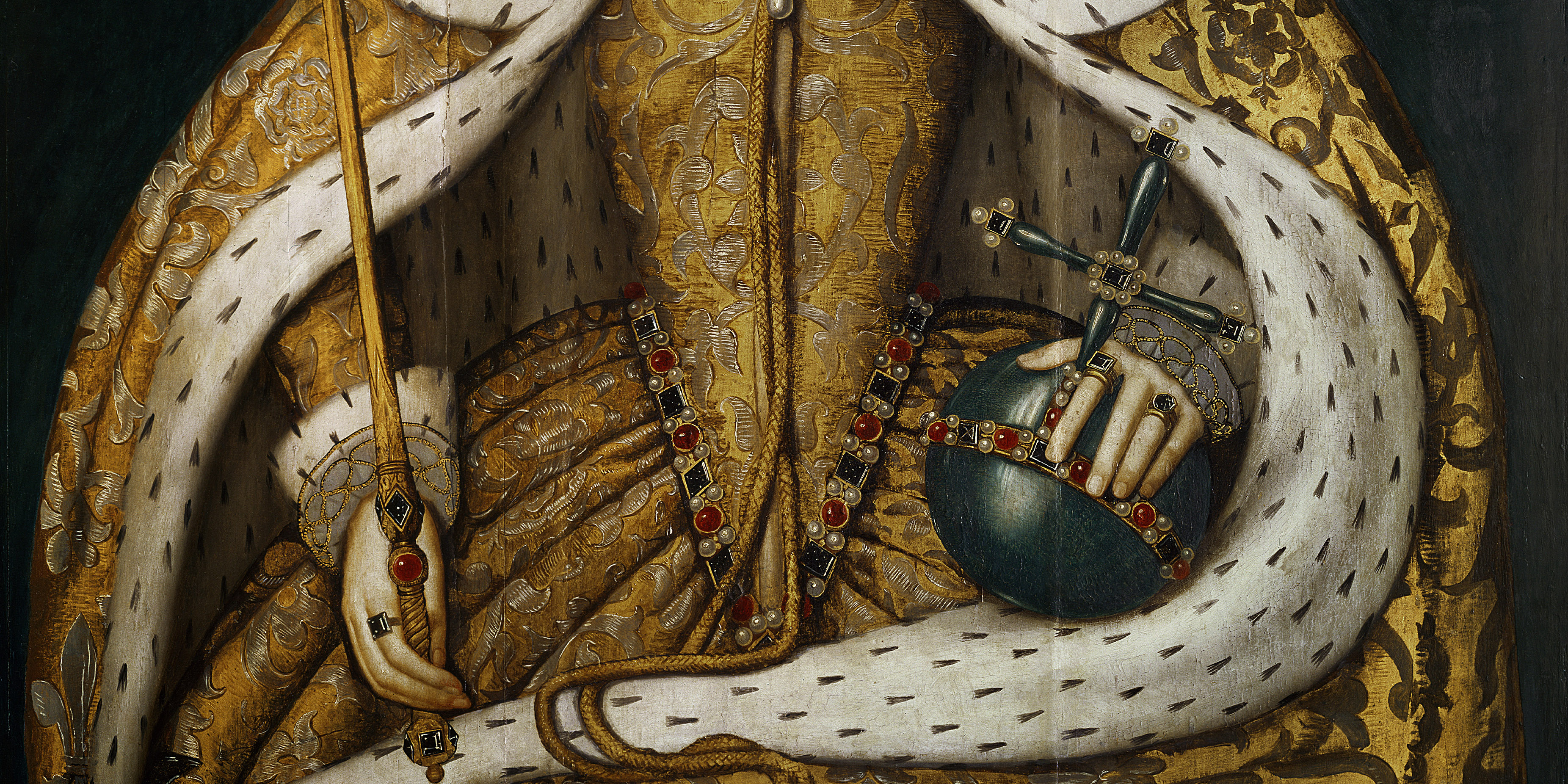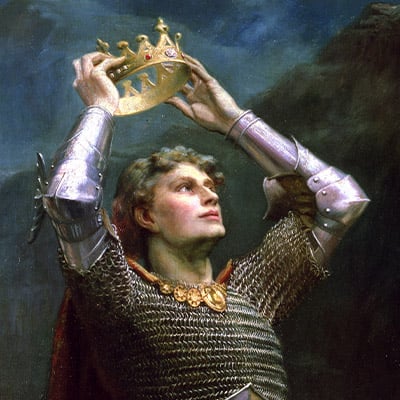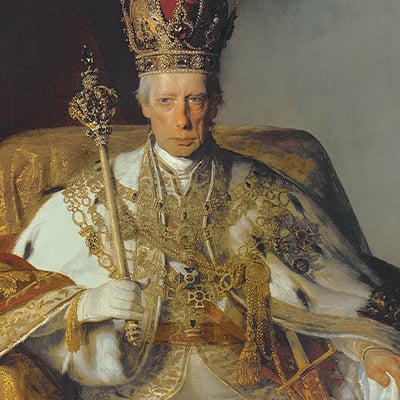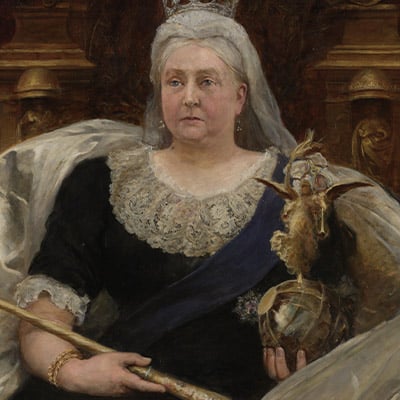
Coronations and Symbols of Power in Art History
With the coronation of King Charles III fast approaching, Bridgeman Images will explore symbols of power within our collection. From ancient crowns to the coronation of Queen Elizabeth II, representations of royal power can feature significant and meaningful symbols throughout art history.
The coronation portrait is an important aspect of the ceremony which began to flourish during the Tudor dynasty in the mid-15th century. Traditionally, state portraits were intricately constructed to portray the authority and strength of the monarch. It is noted that many rulers maintained personal relationships with the artists creating these portraits. The study of these paintings throughout art history arguably moulds how we understand and interpret the power of the British royal family.
The coronation of Queen Elizabeth I (1533-1603) was held on 15th January 1559. This oil painting (c. 1600), by an unknown English artist is referred to as ‘The Coronation Portrait’. It depicts the young Queen crowned. She wears a cloth of gold, which prior to this had been worn by Queen Mary I. Her hair is loose, which historically was typical for a Queen at her coronation. She also holds the orb and sceptre, which act as authoritative symbols of her royal power. This striking piece is now held by the National Portrait Gallery.
Lydia de Burgh (1923-2007) was a distinguished British artist known for her oil and watercolour paintings of members of the Royal family. She was a crafted commercial painter who was known to experiment with oil and watercolour paints. In this portrait, she implements her distinctive style to illustrate the 1953 coronation of Her Majesty the Queen (1926-2022). This painting depicts Queen Elizabeth II in her coronation robes and Imperial State Crown. Although the Queen’s portrait is reminiscent of previous coronation paintings, it depicts her as perhaps more understated and gentle than her ancestors.
%2c%20Winterhalter%2c%20Franz%20Xaver%20(1806-73)%20(after)%20%20Victoria%20%26%20Albert%20Museum%2c%20London%2c%20UK%20%20The%20Stapleton%20Collection%20%20Bridgeman%20Images.jpg?width=450&height=599&name=Portrait%20of%20Queen%20Victoria%2c%201859%20(oil%20on%20canvas)%2c%20Winterhalter%2c%20Franz%20Xaver%20(1806-73)%20(after)%20%20Victoria%20%26%20Albert%20Museum%2c%20London%2c%20UK%20%20The%20Stapleton%20Collection%20%20Bridgeman%20Images.jpg)
This 1859 portrait of Queen Victoria (1837-1901), located in the collection of the Victoria & Albert Museum, draws attention to the crown. In this oil painting by Franz Xaver Winterhalter (1805-1873), the young Queen poses in regal clothing and jewellery. Winterhalter was a German painter and lithographer, he was recognised for constructing rather flattering portraits of upper-class society and royalty. His name became associated with a fashionable style of court portraiture. Here, Queen Victoria is portrayed as authoritative, yet also delicate. The strong sense of power in this artwork is enforced by her robes, jewellery and two crowns.
A portrait of Louis XVI (1754-1793), painted by the French artist Antoine François Callet (1741-1823), portrays the monarch with a sceptre. This ornamental staff is traditionally held in the hand of a ruling monarch as a symbol of royal or imperial distinction. It is designed to represent sovereignty and dominance. Louis XVI holds this object whilst wearing a floral coat and royal insignia. This oil painting demonstrates the power of royal objects to both establish and preserve authority.
%2c%20Warhol%2c%20Andy%20(1928-87)%20%20Private%20Collection%20%20%C2%A9%202023%20The%20Andy%20Warhol%20Foundation%20for%20the%20Visual%20Arts%2c%20Inc.%20%20Licensed%20by%20DACS%2c%20London%20%20Photo%20%C2%A9%20Christies%20Images%20%20Bridgeman%20Images.jpg?width=450&height=599&name=Queen%20Elizabeth%20II%2c%201985%20(screenprint%20%26%20diamond%20dust)%2c%20Warhol%2c%20Andy%20(1928-87)%20%20Private%20Collection%20%20%C2%A9%202023%20The%20Andy%20Warhol%20Foundation%20for%20the%20Visual%20Arts%2c%20Inc.%20%20Licensed%20by%20DACS%2c%20London%20%20Photo%20%C2%A9%20Christies%20Images%20%20Bridgeman%20Images.jpg)
How can symbols of royal power be established within more contemporary art? Andy Warhol (1928-1987) brings these ideas up to date in his ‘Reigning Queens (Royal Edition)’ screen prints (1985). This collection is Andy Warhol’s largest portfolio of silkscreen prints. This technique was crucial to Warhol’s artistic practice. This bold piece brings the idea of royal objects into the twentieth-century Pop Art movement. It was created from a photograph taken in 1977 for Queen Elizabeth II’s Silver Jubilee. This piece incorporates Warhol’s central interests in celebrity, portraiture and the social hierarchy; this offers an interesting take on the notion of the monarch's power.
Our collection features many artworks of coronations and symbols of power, spanning throughout royal art history. Royal authority is ultimately established in many ways, whether through subtly placed objects within larger compositions or through powerful coronation portraits.
Explore our image selections of Symbols of Power in Art History
Images of Crowns in Art History
Images of Sceptres in Art History
Images of Orbs in Art History

%2c%20English%20School%2c%20(16th%20century)%20%20National%20Portrait%20Gallery%2c%20London%2c%20UK%20%20Bridgeman%20Images.jpg?width=450&height=599&name=Queen%20Elizabeth%20I%2c%20c.1600%20(oil%20on%20panel)%2c%20English%20School%2c%20(16th%20century)%20%20National%20Portrait%20Gallery%2c%20London%2c%20UK%20%20Bridgeman%20Images.jpg)
%2c%20Burgh%2c%20Lydia%20de%20(1923-2007)%20%20Government%20of%20Northern%20Ireland%2c%20Stormont%2c%20N.%20Ireland%20%20%C2%A9%20Lydia%20de%20Burgh%20%20Bridgeman%20Images.jpg?width=450&height=599&name=Coronation%20Portrait%20of%20Her%20Majesty%20The%20Queen%2c%201953%20(painting)%2c%20Burgh%2c%20Lydia%20de%20(1923-2007)%20%20Government%20of%20Northern%20Ireland%2c%20Stormont%2c%20N.%20Ireland%20%20%C2%A9%20Lydia%20de%20Burgh%20%20Bridgeman%20Images.jpg)
%20(oil%20on%20canvas)%2c%20Callet%2c%20Antoine%20Francois%20(1741-1823)%20%20Ch%C3%A2teau%20de%20Versailles%2c%20France%20%20Bridgeman%20Images.jpg?width=450&height=599&name=Louis%20XVI%20(1754-93)%20(oil%20on%20canvas)%2c%20Callet%2c%20Antoine%20Francois%20(1741-1823)%20%20Ch%C3%A2teau%20de%20Versailles%2c%20France%20%20Bridgeman%20Images.jpg)


